
All images © by Roberto Piperno, owner of the domain. Write to romapip@quipo.it.
Notes:
Page revised in December 2020.

All images © by Roberto Piperno, owner of the domain. Write to romapip@quipo.it.
Notes:
Page revised in December 2020.
 - Winckelmann's Villa dei Papiri
- Winckelmann's Villa dei PapiriYou may wish to read pages on Mt. Vesuvius in Goethe's Footsteps or on the layout of Herculaneum first.
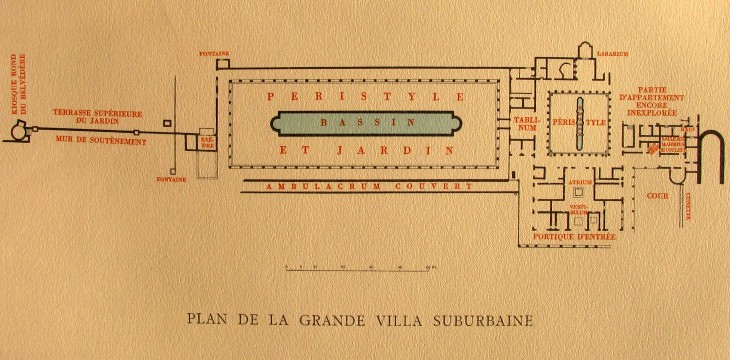
Plan of Villa dei Papiri by Karl Jakob Weber, a Swiss military engineer who was in charge of the excavations of the villa in the 1750s - republished in 1932
Near the chief square of the city there stood a Villa, with a
garden belonging to it, that extended to the sea;
and it was in this house they found the (papyri) manuscripts, of which I shall presently speak; the
marble busts (..) and likewise some fine female statues in bronze. It is proper I should observe,
that in general, the buildings belonging to this
country seat, as well as those of several other
private houses in this place and its environs, had but one story. This country-seat contained
a spacious piece of water, two hundred, and
fifty-two Neapolitan palms in length, and twenty-seven in breadth, terminating, at both ends,
in the arch of a circle surrounded with grass and flower-plants; and, at a greater distance, by
a row of brick columns, covered with stucco, twenty-two on the longest, and ten on the
shortest sides. (..) This country-seat is the only private building worth notice, that has been as yet
discovered in Herculaneum.
Johann Joachim Winckelmann - Critical account of the situation and destruction by the first eruptions of Mt. Vesuvius, of Herculaneum, Pompeii and Stabia - written in 1762 and translated into English in 1771

Modern Ercolano: copies of bronze statues from the peristyle of Villa dei Papiri
The description by Winckelmann refers to a villa which was identified via underground passages and that even today is only partly excavated as it lies beneath the modern city. It was named after the papyri which were found there, but it is also known as Villa dei Pisoni because it was owned either by
Lucius Calpurnius Piso Caesoninus, father-in-law of Julius Caesar, or by his son by the same name.
I shall begin, by telling how
the manuscripts were discovered and then proceed to describe the matter, form, and actual state of them.
When first discovered (..) the workmen (..) could see nothing in these manuscripts, but so many bits of burnt wood, or charcoal. Accordingly, several of them were broken to pieces, and thrown amongst the rubbish. (..) The order, in which these seemingly useless bits of charcoal were afterwards observed to lie, being piled one upon another, was the only circumstance to attract the notice of the workmen, and convince them, that they were
something more than mere charcoal. Soon after, the characters on them were discovered.
They were found (..) in a room so small,
that two men, with extended arms, might touch the sides of it. (..) Some of these manuscripts in rolls were
bound together by a coarser paper. (..) In all probability, the rolls thus bundled together made one
book. These manuscripts, on their appearing to
be what they really are, were collected with great care, to the amount of a thousand, most
of which are preserved in a glass press, and under lock and key, in the cabinet of Portici. (..) These manuscripts are written on the Papyrus or Egyptian reed. (..) No more than four rolls have been as yet entirely unfolded; and these all happen to be
the works of the same author, Philodemus, a native
of Gadara in Syria, and an epicurean. Winckelmann
Some of the finest works of art of Herculaneum were found at the villa and in particular the bronze statues of five young women. They were thought to represent dancers, but today they have been associated with the daughters of Danaus, a mythical king of Argos, who were condemned to spend eternity carrying water in a perforated vessel for having killed their husbands.
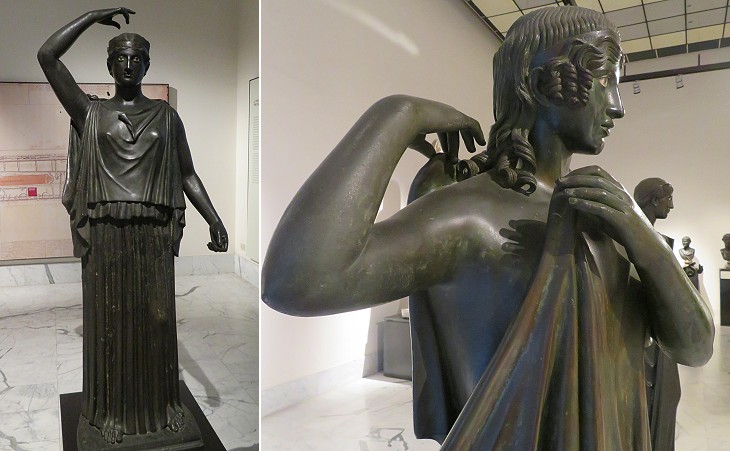
Archaeological Museum of Naples: two of five similar bronze statues from the peristyle of Villa dei Papiri
The female figures are those which formerly stood
in the garden of the villa at Herculaneum alternately with the busts of marble, round the great basin. They are clothed, almost without
action, or any attributes, by which one may
guess whom they were intended for. In a word,
they present no determinate object, though they
are all adorned with diadems. One of them
seems to be about throwing off a short cloak hung
over her shoulders, or fastening it by a button.
Another has hold of her hair, A third is tucking
up her gown a little, as if going to dance. Winckelmann
The detailed description of these statues by Winckelmann indicates that he liked them very much, as he believed them to be examples of the purest Greek art. An element which influenced his judgement was the straight way their draperies fell, i.e. without that "wind" which blew in many Hellenistic statues (and in those by Gian Lorenzo Bernini) which he despised. These statues bring to mind a masterpiece of classic Greek sculpture, i.e. the Charioteer of Delphi, which however was unknown to Winckelmann because it was found in 1896. Today the statues are dated late Ist century BC.

Archaeological Museum of Naples: Drunken Satyr from one end of the pool of Villa dei Papiri
The Silenus (the old satyr who was the tutor and companion of Dionysus/Bacchus) is stretched on a leather bag, covered
with a lion's skin. The fingers of his left hand
are disposed, as if he wanted to crack them. Winckelmann
This statue greatly departed from the canons of art which Winckelmann supported, yet he could not avoid mentioning it, because of its fine workmanship. It is a Roman copy of a lost original which is dated IIIrd or IInd century BC, most likely from Asia Minor (see a mosaic at Ostia depicting Silenus).
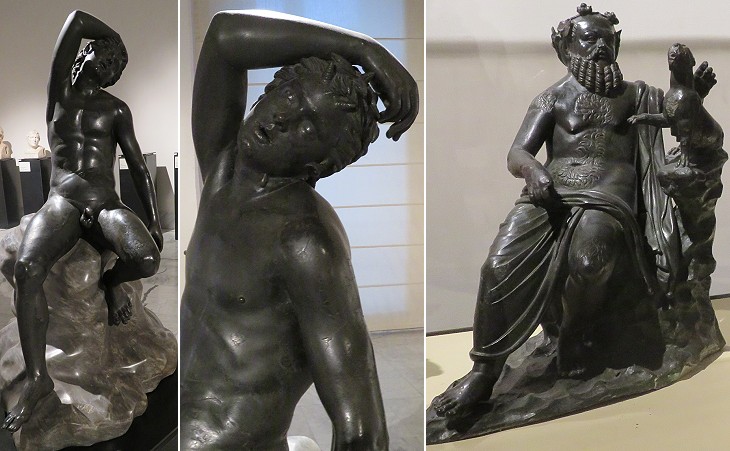
Archaeological Museum of Naples: (left/centre) Sleeping Satyr from one end of the pool of Villa dei Papiri; (right) small bronze statue of Silenus with a panther, a symbol of Dionysus
The young Satyr is seated, and
asleep, with one arm hanging down by its own
weight. Winckelmann
The decoration of the peristyle and of the atrium of Villa dei Papiri was characterized by Dionysiac themes and in particular by statues of satyrs, very often old ones and in a state of repose. Statues of maenads, female followers of Dionysus, who were very often portrayed with satyrs, as at Carthage, were not found.
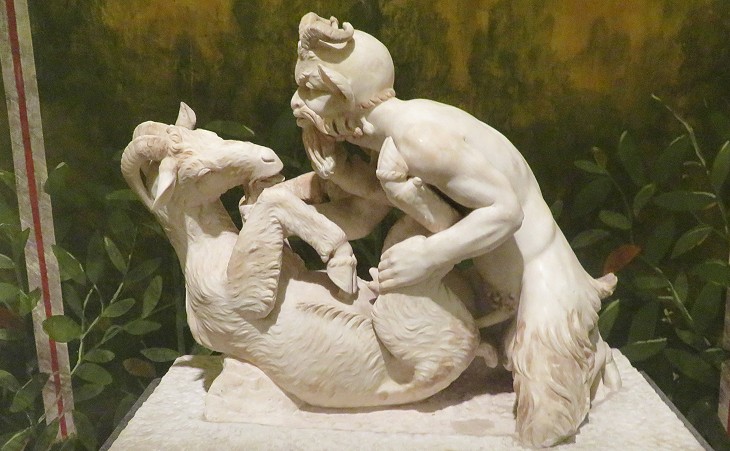
Archaeological Museum of Naples: Pan and the Goat from the peristyle of Villa dei Papiri
You will here Sir be pleased to recollect that the order from his majesty by which I had special admittance to the cabinet was confined to those things which it was lawful to shew. I did not enquire into the reasons of this restriction as I could not but know it regarded the antiquities stored up in the cellars of the castle; particularly an obscene figure which has been condemned to them. However having acquired the confidence of the inspector I had the good fortune to be admitted to see them all except this obscene one which was not to be seen without a special licence signed by his majesty and for which as it had not been solicited by any one else I thought it did not become me to be the first to apply. This piece which is in marble represents a Satyr about three Roman palms in height and a she goat and is said to be of most admirable workmanship. As soon as found it was sent well wrapped up to his majesty then with his court at Caserta who immediately sent it back with the same precautions to be put into the hands of Joseph Canart, his sculptor at Portici with express orders not to let any one see it. We are not therefore to believe some English travellers who tell us they have been allowed that favour. Winckelmann
In 1819 this and other similar works of art, including some from Pompeii, were placed in Gabinetto Segreto, a special section of the Archaeological Museum of Naples, the access to which was restricted. Only in 1971 it was opened to the general public.

Archaeological Museum of Naples: (left) Young Mercury; (centre) fawn, an animal associated with Dionysus, because the god and his followers wore its skin; (right) small statue of a putto
The statue of Mercury, which was
the last found, excels them all. This god is likewise seated. The most remarkable thing, in this statue is the manner, in which the wings are
tied to the feet (you may wish to see a page on feet and sandals in ancient statues). (..) I doubt whether the beautiful Mercury of bronze in the Herculaneum Museum, had originally such chin as it now has, especially as we are assured that the head of it was found broken into many pieces. (..) I must not omit taking notice, that most of the
works in bronze, preserved in the cabinet of Portici, have been repaired and that the doing
of it has robbed them of their antique and venerable rust, that green pellicle or scale, which
the Italians call patina. Winckelmann
King Charles of Bourbon entrusted the restoration of the statues found at Herculaneum with two sculptors from Rome. Joseph Canart took care of the marble ones and Tommaso Valenziani of the bronze ones. In today's opinion they overdid their task by completing all the statues and by redesigning their missing parts in line with the taste of the time, however this had been the common practice since the XVIth century.
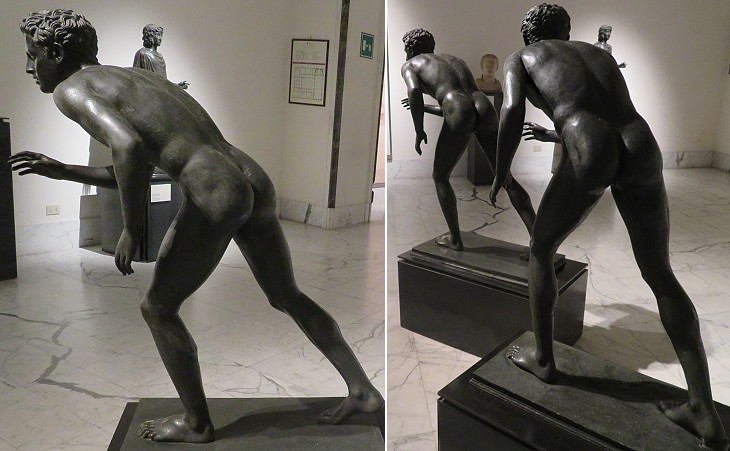
Archaeological Museum of Naples: two runners from the peristyle of Villa dei Papiri
Winckelmann did not mention these two statues among those which he saw in 1762 in the Royal Palace of Portici where they were on display before the inauguration of Museo Borbonico, today's Archaeological Museum of Naples in 1816. Research on the set up of the museum at Portici showed that changes were made after Winckelmann's visit and that the room where these two statues were placed had other exhibits in 1762. The statues were found in 1754 and perhaps they were still being restored. They were initially believed to portray two wrestlers and because of this they were placed facing each other. Additional studies came to the conclusion that they depicted runners. They are currently positioned as if they were athletes taking part in a race, although their right feet suggest they are on the starting line of a stadium.
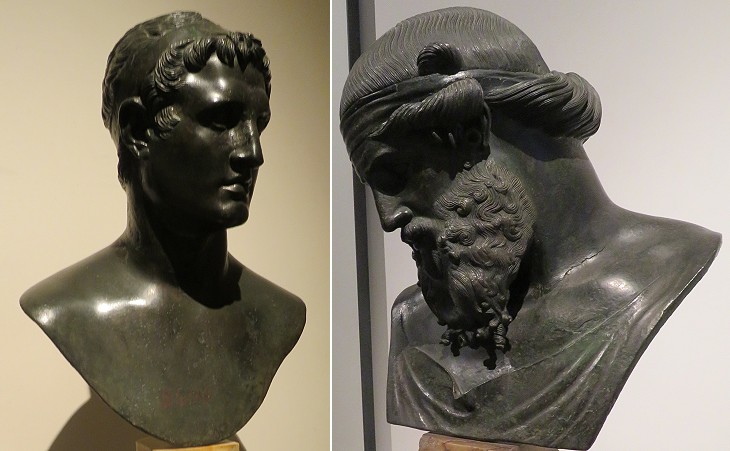
Archaeological Museum of Naples: bronze busts from Villa dei Papiri: (left) a young king of one of the dynasties founded by the generals of Alexander the Great; (right) Plato or more likely Dionysus (as portrayed in the first iconography of the god)
The brazen busts are of different sizes; some as big as life, and others less, some of a middling size, and some even under it, but, in all these sizes, especially the first, this cabinet has greatly the advantage over all others. (..) The buckles formed by the hair of the third head which has a long beard, are foldered only on the sides. The workmanship of this third head is likewise worth our notice, as infinitely superior to that of all our modern artists. It is one of the most perfect pieces in the whole world; and I may take upon me to say that it is impossible for the art of man to produce any thing, in any branch superior to it. They have given it to Plato, but I take it to be altogether ideal. Winckelmann

Archaeological Museum of Naples: bronze busts from Villa dei Papiri: (left) a king of the Seleucid dynasty; (right) a king wearing an elaborate copper headdress
One of these heads, and that
the most ancient (for it has all the characters of
the remotest antiquity) has fifty ring-buckles which look as if they had been formed with
wire of the thickness of a goose-quill. Winckelmann
Archaeologists compared some of the bronze busts with coins and came to the conclusion that they portrayed kings of the Hellenistic period. A bust with a very elaborate headdress which did not match traditional canons of royal iconography has been associated with the kings of Nabatea because of coins of that country. Why the landlords of Villa dei Papiri embellished their property with these busts of kings can be explained with the Roman admiration for everything which came from Egypt and other Eastern Mediterranean countries.
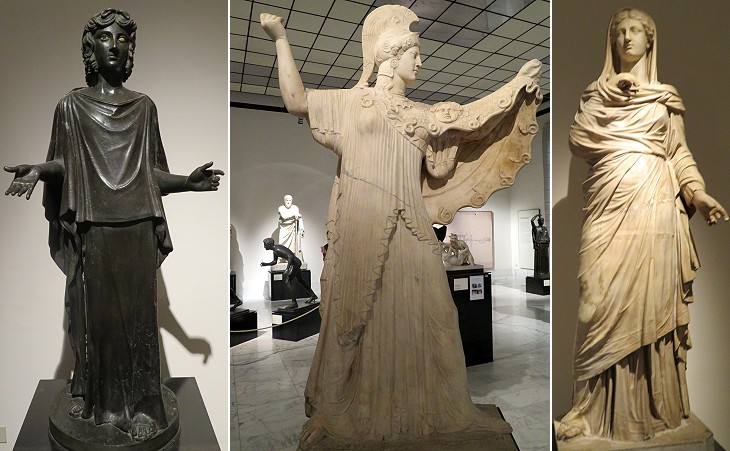
Archaeological Museum of Naples: (left) Hypermnestra; (centre) Athena Promachos (who fights in the front line), a (lost) gigantic bronze statue of her stood in the Acropolis of Athens; (right) Pudicitia
The orders of my violent father struck away fear;
I arise and seize the weapon in a trembling hand.
I will not speak falsehood: three times my hand raised the sharp sword;
Three times it fell back with the evilly raised sword.
I brought it to your throat - let me confess the truth to you -
I brought my father's weapon to your throat.
But fear and duty opposed the cruel act,
And my pure right hand shrank from the ordered deed.
Ovid - The Heroides - Epistula XIV - translation by James M. Hunter
A bronze statue, slightly smaller than life, is thought to portray Hypermnestra, the only of the fifty daughters of Danaus who refused to kill her husband as requested by her father. According to art historians the statue is the result of an XVIIIth century pastiche which combined the head and the body of two different statues.
I am now to speak of the finest marble statues. (..) There is likewise, among the figures, a Pallas as big as life. It is the best of all the marble statues, and, according
to appearance, not of Italian workmanship. It looks almost ancient enough to be of the earliest
ages of Greece. As a proof of what I advance,
I must remark, that the face of this figure wears
a certain character of rudeness, and that the folds
of its drapery are stiff, and form, as it were, so many parallel tubes. (..) She is here represented as running, and raising the right arm to throw a javelin. (..) There
are two figures of women, as big as life, conspicuous for the beauty of their drapery. They
stand in the gallery. (..) Part of her gown, or mantle, is thrown over her head and, in order to cover
it with the greater grace, is made to rise in a point over the forehead. Winckelmann
The statue of the veiled woman is believed to portray one of the landladies of the villa as Pudicitia, Roman goddess of Modesty. It was found near the library.
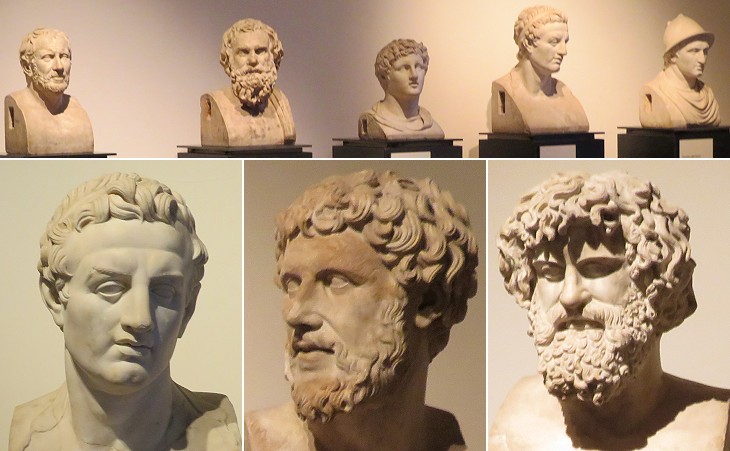
Archaeological Museum of Naples: busts from the peristyle of Villa dei Papiri: (above) kings and philosophers; (below - left to right) a Hellenistic period king, Demosthenes or more likely Bion of Borysthenes, a cynic philosopher, and Menippus of Gadara, another cynic writer
The busts are partly in marble, and partly in
bronze. The first are as big as life, and are suffered to remain in the anti-chamber of the late-queen, that the servant who shews them might
not lose his little perquisites. Winckelmann
The initial identifications of the busts associated them with the most known ancient Greek philosophers and scientists. It is now thought that the busts which are not related to kings portray Cynical or Epicurean philosophers. These school of thoughts became very popular in Rome during the Ist century AD.

Archaeological Museum of Naples: large statues from Villa dei Papiri: (left) Demetrius Phalereus, a IVth century BC Greek orator; (centre) Isocrates, a Vth century BC Athenian orator, or Homer whose head was added; (right) another philosopher
The image used as background for this page shows the bronze spout of a fountain of the villa.
Move to:
Introduction: Mt. Vesuvius in Goethe's Footsteps
Herculaneum - Town Layout
Herculaneum - Monumental buildings and sites
Herculaneum - Houses
Herculaneum - Shops, Baths, Fountains, etc.

